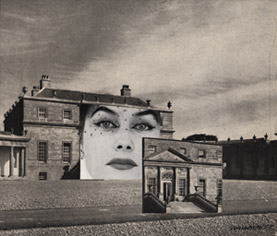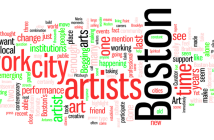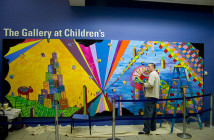Balagan, an experimental film and video series curated by local filmmakers Alla Kovgan and Jeff Silva, brought to us seven works by one of the most important, though relatively obscure film and video artists of the latter half of the twentieth century. Programmed in reverse chronological order, this screening was focused upon Stan Vanderbeek, whose artistry was slowly revealed, getting to the essential core of his achievements.
Vanderbeek was an artist, utopian visionary, and new media pioneer whose influence we still see today. Starting his creative life as a painter and working his way to filmmaking and animation while employed as a set painter for the CBS Children’s show "Winky Dink and You" in the mid-1950’s, Vanderbeek moved on to experimental television and computer animation, holding artist residencies at Boston’s WGBH, NASA, and Bell Labs.
With “Euclidean Illusions” (1980) Vanderbeek seemed to be caught in the magic of medium, playing and experimenting with its properties rather than succeeding in making a solid and enduring work. With its morphing icosahedrons and disco soundtrack, “Illusions” has an æsthetic harking back to the 80’s - a style of geometrics that we see in varying intensities throughout Vanderbeek’s œvre.
Despite the issues with “Illusions” the following six films were exemplary of Vanderbeek’s standing in the canon of American avant-garde. They were all made from the late 50’s through the 60’s, a period of time when Vanderbeek’s work as a filmmaker was most prolific along with his contemporaries, Stan Brakhage, Robert Breer, and so on. After the 60’s Vanderbeek moved on to experiment with “Expanded Cinema” and the emerging forms of new media.
One such film, “Breathdeath,” (1964) was one of the more successful films of the evening’s program. Said to have been dedicated to Charlie Chaplin and Buster Keaton and based on the 15th century woodcuts of the dance of the dead, the film is one of the richest exposes of his techniques and satirical style that has lost none of its potency over the last 40 years. Made mostly with collage animation, in a style very similar to that of Monty Python’s Terry Gilliam, as Gilliam cites “Breathdeath” as the primary inspiration for his own animation. The film’s appearance is much like that of a current John O’Reilly photo collage, but animated. He took popular images known to all of us and placed them into absurd sequences that move before us with a familiarity and smoothness that actually undercuts their absurdity. Thus forcing a diegesis that is funny, disturbing, and telling. Viewers subconsciously weave together their own narrative, which in turn drives each work. A cutout image of Richard Nixon with a foot placed into his mouth is by and large nonsensical, however the picture created received chuckles from the audience (for obvious reasons).
Initially, it seemed that Vanderbeek was jamming the apparent narrative that might accompany images of Nixon, Khrushchev, and the like, subverting dominant institutions through a classically Dadaist method. However, he sews symbols and text together in a way recognizable to our television conditioned minds and a familiar rhetoric becomes palpable. For example, an image of Groucho Marx playing a Harp is placed in the middle of a battlefield and a soldier’s arm sweeps him away; fishermen pull their catch in from the ocean, but what is that caught on their fishing-line? Khrushchev sneezes and an image of Hitler utters the word gesundheit.
During the post screening discussion an insightful audience member commented that you could easily replace the images of Nixon and Khrushchev with current figures and you would have a perfectly contemporary avant-garde film. William Moritz remarked that his films “often moved with an extreme visual velocity that prefigured the MTV video clip fast cutting…” * Granted, his films do have a prescience that could be credited with the ushering in of decades of that often co-opted brand of film. Perhaps avant-garde film has not evolved that much in the last 40 or 50 years. As made evident by this focused presentation by Balagan, Stan Vanderbeek was indeed a part of a group of artists that conceived the language of ‘experimental and avant-garde’ cinema that we all know today.
*William Moritz quoted from www.guildgreyshkul.com/exhibitions/stanvan/
Image courtesy of Guild & Greyshkul Gallery, New York.
Curated by local filmmakers Alla Kovgan and Jeff Silva, Balagan aims to rekindle the spirit and essence of the traditional Balagany experience. Films are screened every other Thursday evening at the Coolidge.
Re:voir
WGBH
Balagan
Guild & Greyshkul
Visual Velocity: Stan Vanderbeek: Underground filmmaker, Media Visionary
Christian Holland has been writing for Big RED & Shiny since its inception, occasionally making movies, herding cats, and dabbling in political consulting. Christian is an executive editor.



